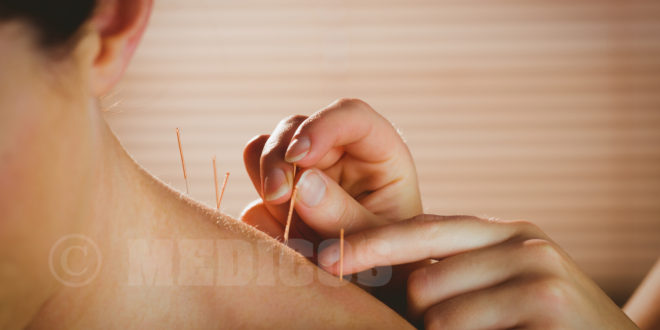Due to the alarming opioid crisis in America, doctors are increasingly looking towards non-pharmacologic ways to treat pain. Among the many methods available, such as massage therapy, spine manipulative therapy, music therapy, etc., acupuncture is considered to be at the forefront in managing chronic pain, especially lower back pain, knee osteoarthritis, and headaches. A US study, “Acupuncture and related techniques for postoperative pain: a systematic review of randomized controlled trials” (British Journal of Anaesthesia, August 2008, https://doi.org/10.1093/bja/aen146) stated that “… acupuncture and related techniques are effective adjuncts for postoperative pain management as demonstrated by a significant reduction of postoperative pain scores and opioid consumption.”
 Based on the results of a meta-analysis study, the American College of Physicians has recommended acupuncture as a first-line treatment for lower back pain. Similarly, another study, “Does acupuncture have a role in providing analgesia in the emergency setting?” (Emergency Medicine Australasia, 2017, https://urlzs.com/MQYCn) showed that acupuncture is comparable to drugs when treating acute back pain in the emergency department. A May 2018 study titled, “Acupuncture for Chronic Pain: Update of an Individual Patient Data Meta-Analysis” (The Journal of Pain, Volume 19, Issue 5) highlighted the following:
Based on the results of a meta-analysis study, the American College of Physicians has recommended acupuncture as a first-line treatment for lower back pain. Similarly, another study, “Does acupuncture have a role in providing analgesia in the emergency setting?” (Emergency Medicine Australasia, 2017, https://urlzs.com/MQYCn) showed that acupuncture is comparable to drugs when treating acute back pain in the emergency department. A May 2018 study titled, “Acupuncture for Chronic Pain: Update of an Individual Patient Data Meta-Analysis” (The Journal of Pain, Volume 19, Issue 5) highlighted the following:
• The effect of acupuncture cannot be explained only by placebo effects.
• Factors in addition to the specific effects of needling are important contributors.
• Referral for acupuncture treatment is a reasonable option for chronic pain patients.
What is acupuncture?
In classic texts, about 356 acupoints located on meridians (pathways) of vital energy flow (Qi) are mapped over the body. Health is compromised when this flow is blocked due to an imbalance between Yin and Yang, where Yin represents the passive principle, which is slow and cold, and Yang the active principle, which is hot and excited. There are 12 main meridians and 8 secondary meridians. The Yin meridians on the arm are of the heart, lung, and pericardium, while the Yang meridians are of small intestine, large intestine, and triple warmer (the area below the navel, housing the intestines, bladder, and kidneys). The Yin meridians on the leg are of the kidney, spleen, and liver, while the Yang meridians are of stomach, bladder, and gall bladder. Good health can be achieved if balance between Yin and Yang is restored, and the aim of acupuncture is to do just that.
Acupuncture involves insertion of 10 extremely fine 32-36 gauge (0.2 mm – 0.13 mm) needles into the skin at the acupoints for 10-30 minutes. Typically, 6-12 sessions are required over three months for a therapy to be completed. Currently, practitioners make use of various techniques in acupuncture therapy. These include basic needling, in which needles are inserted at acupoints and left in place for some time; electro acupuncture, in which focused electric current is applied to the needles, whereby endorphins and enkephalins (opioid peptides that are the body’s natural painkillers) are released, with higher stimulation releasing another opioid peptide, dynorphin; moxibustion, in which a stimulating heat (traditionally, a smoldering herb) is applied to the needles; laser acupuncture, in which a low-energy laser beam is focused on the acupoint; and acupressure, in which pressure is applied on the acupoints to stimulate them.
How does acupuncture achieve results? There are several postulations of its mechanism of action. One is that, acupuncture releases the body’s naturally occurring painkillers (endorphin, which acts within the brain, encephalin, which acts both in the brain and spine, and dynorphin, which acts at the spinal level). Another postulation is called the ‘neurogate theory’, which is similar to trans-cutaneous electrical nerve stimulation (TENS). Similarly, it is postulated that needling could stimulate immunomodulatory factors, including local inflammation. Researchers have also observed an elevation of adrenocorticotrophic hormone after acupuncture, which points towards activation and release of endogenous corticosteroids. On another scale, acupuncture may increase local blood flow to the surrounding area, thus catalyzing the healing process.
To conclude, while acupuncture was once indicated for chronic pain unresponsive to standard therapy, now it is gaining new importance and is even being recommended as a first line therapy for some cases of chronic pain management.
 Medicosnext
Medicosnext




